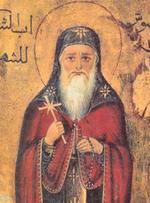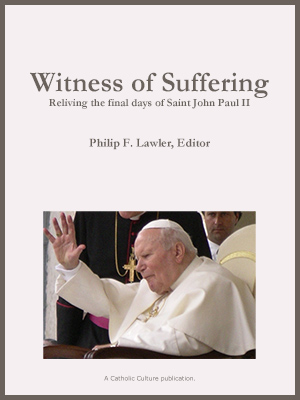The Pilgrim Place of Central Europe
by Zsolt Aradi
Mariazell is the most famous place of pilgrimage in all of Central Europe. When we speak of Central Europe, we include here Austria, parts of Bavaria, Hungary, the Croat and Slovene parts of Yugoslavia and Czechoslovakia. Czestochowa is on the borderline. Its origins are distinctly eastern and it is highly venerated by the Polish people, as well as by the Russians. In the Central European area, which abounds in ancient and modern places of veneration to Our Lady, Mariazell evidently must be something out of the ordinary. The extraordinary element of Mariazell is not the age of its foundation, nor is it the statue itself, nor some outstanding miracle that has won it fame; Mariazell is the most famous because it is venerated by the people of such different and varied nations. They all know of its existence, regardless of national boundaries and distances.
In an area scarred by national strife and century-old feuds, such a phenomenon is extraordinary indeed. The manifold pilgrimages to the shrine of Mariazell also justify its high rank. The pilgrims took all their problems, material and spiritual, with them to the feet of the Madonna. No other church or shrine can claim ex-votos of so many different nationalities as Mariazell.
The origin of this place of pilgrimage, high up in the Austrian Alps in the province of Styria, surrounded by picturesque mountains, green meadows and dense forests, dates back to 1157, when a Benedictine monk named Magnus left the Abbey of St. Lambrecht to retire into the wilderness, taking a small statue of the Madonna and the Child with him. At a certain point, he could not proceed because of the thickness of the forest and he saw that farther on, some rocks were blocking his passage. He prayed to the Blessed Virgin and, the legend says, the wilderness and rocks opened to make way for him. Soon after he stopped and decided to set up his abode on that spot. He placed the statue on a white branch of a tree. As time passed shepherds and hunters came to him and he became their priest.
A few years later, with the help of these people, he built a little chapel around a linden tree. This is the same statue, which has, ever since, been venerated at Mariazell. Despite its age, the woodcarving does not show signs of decay. The statue of Our Lady of Mariazell is twenty-two inches high, carved in linden wood; the serene gaze of the Holy Virgin is directed upon the onlooker.
Written records of many pilgrimages dating back to the fifteenth century mention that people saw her face, eyes, and lips moving as if she were alive. The pilgrims from these various nations returned to their homes with a message from the Holy Virgin, given to their prayers or requests.
The first church, a Romanesque one, was built around 1200. Later on, it was amplified by large donations from Heinrich, Count of Moravia, after he and his wife were saved from a terrible illness. About 1340, an even greater church, to replace the Romanesque, was erected by King Louis the Great of Hungary. Aided in a dream by Our Lady, he defeated the Turks and Bulgarians, who at that time represented one of the most serious menaces against the Christian West. The third transformation of the church into a superb Baroque edifice occurred in the late seventeenth century. Its architect was an Italian; the high altar and the interior are the work of that most famous Austrian Baroque architect, the older Fischer von Erlach. It is said that during this last reconstruction work, the linden tree, the original dwelling place of the image of Our Lady, was found.
One of the curiosities of the church is the fact that it has three spires, two of them of Baroque design and between them a Gothic spire.
The history of Mariazell, as we have said, is not primarily a history of spectacular events. Nevertheless, during at least six hundred years, kings of Hungary and Austria bestowed favors and precious gifts upon her. Its treasury can be equaled only by the treasury of Altotting. At the end of the thirteenth century when Vienna became the capital of the Hapsburg Empire, Mariazell became the most cherished shrine of the Austrian dynasty and nobility. But, as we have noted, its fame rests largely upon the confidence in the Beloved Lady by the people of Central Europe, particularly the Austrians. From the end of the thirteenth to the end of the seventeenth centuries, when large parts of Southeastern and Central Europe were devastated by the Turks, cathedrals comparable in fame to the great French and German churches and other holy places dedicated to the Madonna, were leveled to the ground. The only famous cathedral in this borderland of the West, which remained untouched by the ravages of wars was that of St. Stephens in Vienna. And the only great shrine where the open veneration to the Blessed Virgin never stopped --except in grave dangers, when the image was concealed-- remained Mariazell.
The people to the east of Austria who were subjugated by the Turks gave their blood for the defense of the West, their motherland; nor did the West abandon them. The idea of liberation and of the Christian peace among all nations on a supranational level remained vigorously alive in the Catholic Church of Austria and it was the unquenchable spirit that finally organized the forces of liberation needed to drive the Turk invader from southeastern Europe.
This sanctuary is fundamentally Austrian, though cherished by different nations. The devotion to Our Lady has no national boundaries and her favors are not accorded with these limits. When we say that Mariazell is fundamentally Austrian, we have in mind that spirit of pacification, which was, for many centuries, the mission of Austria. This Gate of the Peace was erected on Austrian soil to enable the people of that country and of the various surrounding strife-torn nations to crystallize their best desires in the person of the Blessed Virgin, the Queen of Peace.
Thus, the history of Mariazell is primarily the history of the miracles occurring in the souls of tens of thousands of simple people; members of the aristocracy, rulers and high officials who came here divested of their official robes and symbols of importance; few people could distinguish them from the masses. Everybody did, and still does, the same penance. They advance, kneeling, up the main stairway with arms outstretched, or they carry heavy blocks of stone to commemorate those who also, out of penance, helped to build the church. There were and, sometimes still are, unforgettable scenes when the procession stops and the pilgrims prostrate themselves on the ground. People who cannot make the pilgrimage but feel that their prayers to Our Lady of Mariazell have been heard, write letters which are preserved in the archives. This custom still prevails today. The letters are addressed: "To Our Beloved Mother of Grace."
And those who arrive with their pilgrim brethren leave uplifted but still with sorrow because they have to depart from her. One of the most moving songs of the pilgrims goes like this:
O Maria, you are my life,
My heart breaks inside me
For I must now take leave of you
And separate myself from your presence.
And while the departing pilgrims march under their banners, they look back upon this Gate of Peace and remember forever the inscription above the church portal:
Maria, the creation of Heaven and Earth
Is being praised in you.
This item 3057 digitally provided courtesy of CatholicCulture.org






